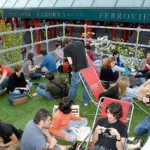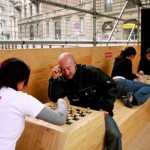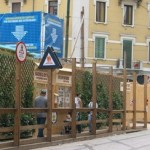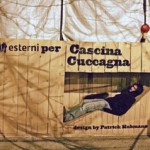Every spring, once the last patches of dirty snow are gone, the meteorological-natural alibi for all difficulties with which the brave fighters in urban pentathlon must cope with every day – walking on the pavement, avoiding ditches and 4X4 cars parked or driving on the road freely, passing by the building sites… Well, you are familiar with them all, aren’t you?
If bitter winters (are we the only one in Europe to experience snowing?) make us find an excuse or bear with such troubles, once the blades of grass grow, we start asking questions: what could be done, how could we change this condition that takes a toll on us, a part of our daily “Zen”? Could our streets become a civilized transition place? Can public space become one shared by everyone instead of being no man’s land forever? The same questions were asked by a group of Milan visionaries, very much in love with the city and extremely tenacious and desperate like any other person in love. They can no longer bear with the way in which the urban space is neglected and damaged by public administration and, equally, by city dwellers. So, faced with the dilemma of “leaving a place dumb and deaf to those who would like to live the urban experience to the fullest or staying there and try to bring some changes,” they chose the second.
This is how the Esterni Association was set in 1995, based on Lorenzo Castellini, Benjamino Saibene and Carlo Giuseppe Gabardini’s utopian project. They intended “to invent isles of cultural debate in public spaces” that were mostly derelict, by appealing to group dynamics as a clotting ingredient. The idea was involuntary genial like any simple thing: to gather masses of people around an attractive cultural event, within a place everyone used to ignore or “experience” that space only by passing it by briskly.
Esterni has developed into a mental spotlight that brings the most neglected corners of the city to light. One by one, every square that the fashionable world of bars and cafes has forgotten, the abandoned industrial ships and popular peripheries relish their moment of urban celebrity. An 18-member team of various professions – architects, designers, film directors – finishes almost ten projects a year; they all focus on the revitalization of the public space through various ephemeral interventions. Among their numerous initiatives one could mention the pump-up screens for ad-hoc cinema projections; the mobile groups containing in-built bench and tree that create comfortable places for various relaxation areas; the museum of instant art – equipped areas for expressing one’s creativeness freely; the sfacciata panels that can be assembled anywhere in the city to create instant stopovers (sfacciata stands in Italian for insolent, naughty, daring and mocking, but here the world also aludes at facciata – the façade).
However, their major project is the Milano Film Festival, a yearly short reel festival, which became one of the the city’s landmarks.
Design Pubblico is another initiative that takes place concomitantly with the Furniture Salone; in 2008, it dealt with building sites – significant places in the city under construction; this is a recurrent happening in their calendar.
In fact, every theme they choose is reflected in an architectural idea that goes beyond simple constructions (architecture beyond buildings – as Aaron Betsky defined it in the recent Venice Biennial). Yet the vital force of the Esterni group is the teamwork, constantly confronted by and contaminated with ideas coming from the outside. Their projects are published on the association site from their early stage, and people’s comments and suggestions are transferred on the drawing board, thus resulting in true forms of democratic design happening.
The Esterni experiences show that they are not simple meetings meant to discuss about the ideal city or events orchestrated by a professional team to which the interested public may take part (ina passive way). Esterni wishes to be a catalyst of urban ideas and develop them by inviting the most dynamic urban actors, the city dwellers.
Paraphrasing Kennedy’s mot, theirs is “Don’t ask what the city can do for you, but what you can do for the city.” Assuming that urban development process results from the interaction between public and private actors, and that any intervention, or its absence, concerns the city dwellers directly, Lorenzo Castellini firmly believes that the dwellers’ should have the major contribution. So, I asked him what he thinks about the public’s role in Esterni’s actions and, in general, in the process of city’s change.
VN: Do you think that Esterni will succeed in making the participants into your events perceive the public space as one useful for everyone, and not just no man’s land?
LC: Yes, I think that in years people’s sensitivity as to public space themes and the way “it is experienced” has grown significantly. However, the administration’s sensitivity did not change in the least. The Milan public space, when it is not completely neglected or an easy prey to real estate speculation is not really enhanced.
VN: What is your target-audience?
LC: Most people participating into our actions are 20 to 40 years and have various interests, from cinema, design, graphics, to politics.
VN: What sort of responses have you got so far?
LC: Positive, I would say. We succeeded in creating our own public who’s been interested in our events and, in fact, grew up with us. Moreover, there are new participants that did not know we existed, but that are co-opted due to the capacity of our projects to draw active participation.
VN: Do you think that Esterni awakened a vivid interest for the way in which public space, beyond your own activities, is used and managed?
LC: Oh, yes. The ideas we proposed years ago are now on public agenda. We pioneered such ideas and invented a new discipline: public design.
VN: As a rule, this kind of activism is understood as participation into demonstrations or neighborhood meetings vacillating between boredom and belligerent arguments. However, you initiate events that have nothing to do with discourses; yours are hands-on actions useful for your city, and create places where people can chat, dance, laugh… Do you think that your playfulness definitely contributes to attract people into community debates?
LC: It is a very effective way to pursue our goal. You shouldn’t necessarily be stiff and rigid to approach serious themes. It is vital that the public should feel good and have fun.
VN: How do you get funding for your project? Do the City Hall and Local Administration help you?
LC: Our projects are funded either by private sponsors who believe in us and by the interested public.Moreover, Esterni re-invests all its money in the next projects, since it is a non-lucrative organization.
VN: What is the relationship between the Esterni Association and Milan administration, considering the fact that you deal with public space?
LC: Our relationship grew stronger over the years, and I would say it is positive. However, we are critical and get nothing without fighting.
VN: How did come to export your initiatives to other cities? How did they respond?
LC: That developed naturally. It is true that our projects started from our deep knowledge of Milan’s problems, yet, they are the same in every modern city. We wished Esterni would develop constantly. We are already in touch with hundreds of people and had new experiences
in every city.
VN: Do you think that your initiatives contribute to the education of a less passive and more critical population?
LC: This is indeed a long a painstaking process. Obviously, those who participate into our activities remember the experiences they lived. As Goffredo Fofisays, “we spread seeds and hope they will make one to be alive”.
VN: Do you think the Esterni group “democratizes” the urban space?
LC: Our goal is to make urban space be perceived as everybody’s space, a place where you can experience democracy. All our projects pursue this direction.
VN: Bucharest is being mistreated by all those “wild” real estate promoters, and besides the destruction of the architectural heritage, we witness the rapid disappearance of public spaces vital for city life (ill-used parks,squares, buildings randomly “given back” to their former
owners). Such destructions take place due to the people’s lack or interest or inability. Can one awake the “urban consciousness” through Esterni-like initiatives?
LC: From our experience, we’ve found that the most attentive factors to such things are those who are not involved (professionally) into the city building. On the other hand, the professionals should be made alert
culturally, socially, and not just technically, to urban problems. The only solution to it is to try! We are ready to come to Bucharest, if welcome!
Let us hope that this proposal will be an Esterni initiative in Bucharest. Meanwhile, the Esterni projects could be viewed on their site www.esterni.org and www.designpubblico.it
Translation: Magda Teodorescu
Photo: Esterni, Voica Nicolaescu






